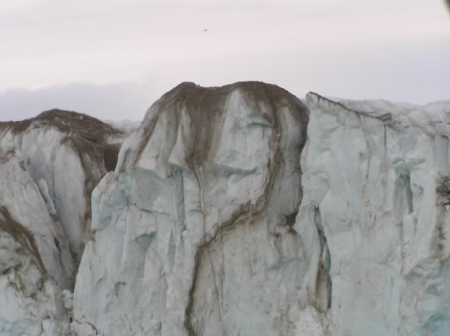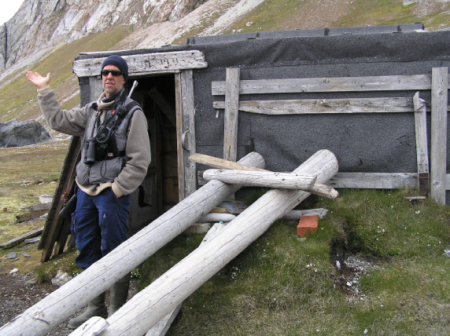First Landing
After boarding the ship we sailed over to a nearby glacier.
 |
 |
| Glaciers are extremely common in Svalbard--we had seen dozens as we flew in and would see many more as we sailed through. |
This one, however, had an image of a laughing Jesus on it, which made it somewhat different. Pat thought of auctioning it on eBay, but couldn't come up with a way to preserve it. |
 |
 |
| At 10:00 pm the sun was still high enough to make interesting patterns in the unusual cloud formations. During the trip the sun did not, of course, set at all. | The next morning Chuck spotted the first of the strangely-shaped ice formations we would see. This is a "bergy bit, " while larger pieces of floaring ice are called icebergs. He dubbed this one "the crocodile." |
 |
 |
| We made our first landing at Hornsund, a wonderful deep fjord in the southern part of Spitzbergen Island. | There was a complex polar bear protocol before we landed anywhere that began with launching a Zodiac. |
 |
 |
| A naturalist then took the Zodiac and cruised up and down the landing site to check for polar bears. |
Once that was cleared, a group of naturalists went over and searched for hidden polar bears. |
 |
 |
| Once guests were allowed to land, also via Zodiac, naturalists cruised up and down the coast looking for bears and all the naturalists were on the alert. |
Every naturalist was armed at all times. Pat asked one if he was a good shot. His answer was, "Well, I took an NRA course." Not the answer she was looking for. |
 |
 |
| While they were doing all that, we had a chance to go through the long process of getting ready to go ashore. What the well-dressed adventurer was wearing: waterproof boots (for jumping from Zodiacs into freezing water), insulated waterproof pants over jeans, a parka over a shirt and sweater, gloves, scarf, wool hat (here covered by a waterproof hood against the rain), camera, and binoculars. Whew! Made hiking a challenge. Yes, those are walruses behind us--more on them later. |
|
 |
 |
| The Expedition Leader was Tom Ritchie. Whenever he came to a corner he would yell, "Hey, Bear!" Pat wondered if a bear would pop up and say "Hi, Tom." But he was VERY good at his job. | There were 12 naturalists on board, ranging from an undersea specialist to an ex-trapper,
as well as generalists like Tom and several photography experts (after all, this is National Geographic). One of the experts was a botanist and encouraged us to look closely at the plants, which seldom grow to more than two or three inches tall. |
 |
 |
| It was late in the year, but this glaucous gull still had a couple of chicks. |
Most of the plants are dwarf versions of familiar plants, like this buttercup. |
 |
 |
| Others are less known down south, like the saxifrage--the most common flower we saw. |
The naturalist, Steve MacLean, demonstrated how to "assume the position" to do arctic botany. |
 |
 |
| Naturalist Stefan Lundgren told us about the old trapper's cabin--where another of our naturalists had spent his honeymoon. In this environment, even wooden buildings last for decades or longer--unless they are damaged by polar bears. | Afterwards Pat climbed up the hill (NOT with Mike) for a better view. |



